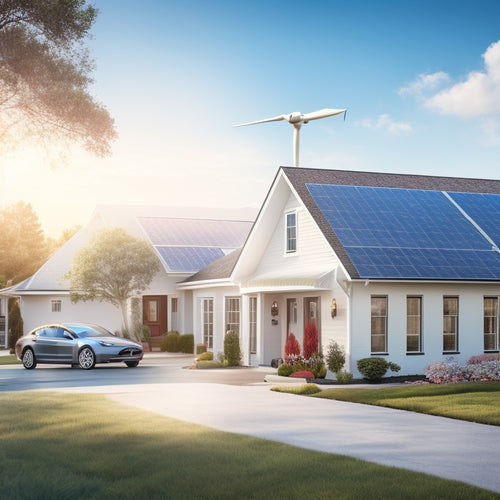
What Role Does Solar Energy Play in Electricity Markets?
Share
As you navigate the changing environment of electricity markets, you're likely to notice a significant shift towards renewable energy sources, with solar energy emerging as a key player, accounting for approximately 3% of the total electricity market share in 2020. Driven by declining costs and increasing demand, solar energy has become an essential component of the renewable energy mix, with cumulative installed capacity exceeding 720 gigawatts. As you investigate the solar energy market, you'll uncover its role in grid integration, energy storage, and policy structures, ultimately altering the way you think about electricity generation and its future path.
Key Takeaways
- Solar energy plays a crucial role in the renewable energy mix, driven by technology advancements and decreasing costs.
- Solar energy contributes to grid stability through energy storage systems and load balancing, ensuring reliable power supply.
- Community solar initiatives allow shared benefits from single solar arrays, increasing adoption rates and energy equity.
- Solar energy is becoming increasingly competitive with traditional sources, achieving grid parity in many markets.
- Declining costs and policy support position solar energy as a key player in future electricity generation, promoting energy independence and climate resilience.
Solar Energy Market Share
As the global energy environment continues to evolve, solar energy has emerged as a significant player, claiming approximately 3% of the total electricity market share in 2020.
You're likely wondering what drove this growth. The answer lies in the solar adoption trends, which have been fueled by declining costs and increasing demand. As a result, solar energy has become more competitive with traditional fossil fuels, leading to a shift in the market framework.
Today, you're witnessing intense market competition, with solar energy providers vying for a larger share of the market. This competition has driven innovation, with companies investing heavily in research and development to improve efficiency and reduce costs.
As a result, the cost of solar energy has decreased dramatically, making it more accessible to a wider range of consumers. You're now seeing solar energy becoming a viable option for both residential and commercial customers, leading to increased adoption rates and a growing market share.
Renewable Energy Sources Comparison
You're now comparing solar energy to other renewable energy sources, wondering how it stacks up against the competition. As you explore the world of renewables, you'll find that each source has its strengths and weaknesses.
Wind energy, for instance, is a close competitor to solar, with similar variable output and geographical limitations. Hydroelectric power, on the other hand, offers a more consistent supply, but is restricted to areas with suitable water resources.
Geothermal energy and biomass energy have their own niches, with the former requiring specific geological conditions and the latter being more suited for small-scale, local applications.
Nuclear power, while not renewable in the classical sense, is often lumped in with renewables due to its low carbon emissions.
When considering energy efficiency, solar energy holds its own against fossil fuels, but market fluctuations and technology advancements are constantly shifting the playing field.
As you weigh the environmental impact of each source, it's clear that solar energy has a significant role to play in the shift to a cleaner, more sustainable energy mix.
Electricity Generation Capacity
You're now examining the electricity generation capacity aspect of solar energy in electricity markets.
As you analyze this component, you'll notice that solar capacity has grown considerably, altering the renewable energy mix.
This shift is largely driven by power plant additions, which have been steadily increasing to meet rising demand for clean energy.
Solar Capacity Growth
By the end of 2020, solar power had become a significant contributor to the global electricity generation mix, with a cumulative installed capacity of over 720 gigawatts (GW).
You're likely wondering what drove this growth. The answer lies in solar technology advancements, which have led to a dramatic decrease in the cost of solar panels and improved their efficiency. As a result, solar energy has become more competitive with fossil fuels, making it an attractive option for power generation.
However, as solar capacity continues to grow, you'll face grid integration challenges. Solar power's intermittency requires advanced weather forecasting and grid management systems to guarantee a stable supply of electricity.
Additionally, the variability of solar power output necessitates the development of energy storage solutions to mitigate the impact of sudden changes in generation.
Despite these challenges, the growth of solar capacity is expected to continue, driven by increasing demand for clean energy and declining technology costs.
As you maneuver through the intricacies of electricity markets, understanding the shifts of solar capacity growth is essential for making informed decisions.
Renewable Energy Mix
As the global electricity generation mix undergoes a significant change, the renewable energy mix takes center stage, with solar energy playing an essential role in this shift.
You're likely to see solar technology advancements driving down costs and increasing adoption rates. Community solar initiatives are also on the rise, allowing multiple individuals or organizations to share the benefits of a single solar array.
Photovoltaic efficiency improvements have been instrumental in reducing the levelized cost of electricity from solar, making it more competitive with fossil fuels. Solar energy incentives and policy support have further accelerated growth, while distributed generation benefits have enabled consumers to take control of their energy production.
Solar project financing options have become more accessible, and rooftop solar adoption continues to increase. Additionally, solar thermal applications are gaining traction, and solar energy education is becoming more widespread.
However, you should be aware of the solar integration challenges that come with incorporating intermittent renewable energy sources into the grid.
Power Plant Additions
Solar energy's growing presence in the renewable energy mix has paved the way for increased electricity generation capacity through power plant additions. As you consider the role of solar energy in electricity markets, you'll see that power plant additions are a vital aspect of scaling up solar capacity.
Community solar projects, in particular, have gained traction, allowing multiple individuals or organizations to share the benefits of a single solar installation.
Utility investments in solar energy have also driven power plant additions, with many companies recognizing the value of diversifying their generation portfolios.
Grid integration is a significant factor in this process, as utilities must guarantee that solar power can be reliably fed into the grid.
Technological advancements have improved the efficiency and cost-effectiveness of solar power, making it more competitive with fossil fuels.
Financing models, such as power purchase agreements, have also facilitated project development.
Policy incentives, like tax credits and net metering laws, have further spurred growth.
As the energy shift gains momentum, market fluctuations will continue to change, driving innovation and investment in solar power plant additions.
Peak Sun Hours Impact
You'll find that peak sun hours have a significant impact on a solar energy system's daily energy output.
This is because the amount of energy generated by a system varies directly with the amount of solar irradiance it receives, which is typically measured in peak sun hours.
As you analyze the data, you'll notice that seasonal variations in peak sun hours also matter, affecting the system's overall performance and electricity generation capacity.
Daily Energy Output
Daily energy output from solar panels varies considerably depending on the availability of peak sun hours. As you maneuver through the intricacies of electricity markets, understanding this variability is essential. Peak sun hours directly impact the amount of energy your solar panels can generate, which in turn affects your daily energy output.
To accurately forecast your solar output, you need to evaluate daily consumption patterns. This involves analyzing your energy usage habits, factoring in elements like time of day, weather conditions, and seasonal changes. By doing so, you can better predict your energy needs and adjust your solar output accordingly.
Solar output forecasting is particularly important in electricity markets, where supply and demand are constantly fluctuating. By accurately anticipating your daily energy output, you can make informed decisions about energy storage, grid connectivity, and overall energy management. By doing so, you can optimize your solar energy production, ensuring a reliable and efficient supply of power.
Seasonal Variations Matter
As energy output forecasting becomes more refined, it's clear that seasonal variations play a significant role in peak sun hours.
You'll notice that solar energy generation profiles fluctuate throughout the year, influenced by climate conditions and weather patterns. This solar seasonality affects the overall performance variability of your solar power system.
During peak sun hours, typically occurring during summer months, your system's capacity factors are higher, resulting in increased energy output.
However, when winter months bring shorter days and more cloud cover, your system's performance dips. These seasonal fluctuations can impact demand fluctuations, making it essential to take into account energy forecasting and grid integration strategies.
To mitigate these effects, you may need to invest in seasonal storage solutions, ensuring a stable energy supply throughout the year.
Grid Parity and Economics
The tipping point for solar energy adoption is often reached when it achieves grid parity, meaning the cost of generating electricity from solar power is equal to or cheaper than the grid electricity price.
As you consider investing in solar energy, you'll want to understand the economic interactions at play. Incentive programs, such as tax credits and rebates, can notably reduce the upfront costs of solar installations, making them more competitive with traditional energy sources.
Investment trends suggest that as the cost of solar panels continues to decline, more consumers will adopt solar energy, driving demand and further reducing costs. Market interactions, including pricing mechanisms and consumer behavior, will play a vital role in shaping the growth of the solar industry.
Technological advancements in grid integration and financing models will also be essential for widespread adoption.
Energy Storage and Grid Stability
You're likely wondering how solar energy systems will maintain a stable flow of power when the sun isn't shining. The answer lies in energy storage, a vital component of grid management. Advanced battery technology enables utilities to store excess energy generated during the day for use during periods of low solar output or high demand. This guarantees a stable and reliable flow of power, enhancing energy resilience.
Demand response programs also play a key role in maintaining grid stability. By incentivizing consumers to adjust their energy usage during peak hours, utilities can reduce strain on the grid and prevent brownouts.
Renewable integration is further facilitated by load balancing, which matches energy supply with demand in real-time. This is made possible by advanced grid modernization efforts, which prioritize system flexibility and peak shaving.
As the share of solar energy in the grid increases, energy storage and grid management will become even more essential. By leveraging these technologies, utilities can guarantee a reliable and efficient supply of power, even when the sun isn't shining.
Policy and Regulatory Framework
A strong policy and regulatory structure is essential for solar energy to thrive in electricity markets. You need a clear understanding of the policies and regulations that govern the industry to maneuver the intricacies of solar energy integration.
| Category | Policy/Regulation | Impact |
|---|---|---|
| Incentives | Tax credits, grants | Encourages investment in solar energy |
| Compliance | Renewable Portfolio Standards (RPS) | Guarantees a certain percentage of energy comes from solar sources |
| Market Integration | Net metering policies | Allows households to generate and sell excess energy back to the grid |
| Interconnection | Grid connection standards | Secures safe and efficient connection of solar systems to the grid |
| Energy Independence | Subsidy reforms, carbon credits | Promotes energy independence and reduces carbon emissions |
As you explore further into the policy and regulatory structure, you'll encounter various incentive programs, regulatory challenges, and policy impacts that affect the integration of solar energy into electricity markets. Compliance standards, market integration, and interconnection issues are just a few of the key aspects you need to think about. By understanding these factors, you can better maneuver the intricate environment of solar energy policy and regulation, ultimately driving investment incentives and energy independence.
Solar Energy Cost Trends
Solar panels, once a pricey alternative to traditional energy sources, have witnessed a dramatic decline in costs over the past decade, making solar energy a more competitive option in electricity markets.
You've likely noticed that the cost of solar panels has dropped considerably, making them more accessible to both residential and commercial consumers. This decrease in cost is largely attributed to advancements in solar panel efficiency, which have led to higher energy output per unit area.
Additionally, installation incentives, such as tax credits and rebates, have played an essential role in reducing the upfront costs of solar energy systems.
As a result, the levelized cost of electricity (LCOE) from solar energy has decreased dramatically, making it more competitive with traditional fossil fuels. In fact, the LCOE from solar energy is now comparable to, or even lower than, that of natural gas and coal in many regions.
This trend is expected to continue, driven by ongoing innovations in solar panel technology and economies of scale in manufacturing.
Future of Electricity Generation
As the cost of solar energy continues to decline, it's becoming increasingly clear that this renewable energy source is set to play a significant role in shaping the future of electricity generation.
You'll likely see a shift towards decentralized generation, where individuals and communities take control of their energy production through community solar initiatives. This move towards energy democracy will promote energy equity, ensuring that everyone has access to clean, affordable energy.
Smart grids will play a vital role in managing the variable output of solar energy, allowing for seamless integration into the grid. Technological innovations will further drive down costs, making solar energy a competitive option for electricity generation.
As a result, you can expect to see increased job creation in the solar industry, contributing to energy independence and climate resilience. The future of electricity generation is certainly solar-powered, and you'll be at the forefront of this change.
With solar energy, you'll be utilizing the power of the sun to fuel your home, business, and community, creating a sustainable energy environment for generations to come.
Frequently Asked Questions
Can Solar Energy Power Entire Communities Independently of the Grid?
You'll be surprised to know that 100% of Costa Rica's electricity came from renewable sources, including solar, for 300 days in 2020. You can achieve solar independence, ensuring community resilience, by integrating solar power with energy storage and smart grids to power entire communities off-grid.
Are Solar Panels Recyclable at the End of Their Life Cycle?
You'll find that solar panels are recyclable, thanks to innovative recycling processes that extract useful materials like silicon, aluminum, and glass from retired panels, minimizing waste and reducing the industry's environmental footprint.
Do Solar Farms Affect Local Wildlife and Ecosystems?
You're utilizing the power of the sun, but are you unwittingly disrupting the delicate balance of ecosystems? Solar farms can cause habitat disruption, species migration, and alter land use, ultimately threatening ecosystem balance - a dark side to your renewable energy pursuit.
Can Solar Energy Be Used to Power Electric Vehicles Directly?
You can power electric vehicles directly with solar energy through solar charging systems, seamlessly integrating your vehicle with solar panels, allowing you to utilize renewable energy and reduce your carbon footprint.
Are There Solar Energy Systems Suitable for Urban Apartment Buildings?
As you gallop into the 21st century on your trusty steed, you'll find solar energy systems customized for urban apartment buildings, featuring rooftop installations and community solar programs, offering a feasible, clean power solution for your high-rise habitat.
Related Posts
-

What You Need to Know About Permits and Inspections
You need to navigate the complex landscape of permits and inspections to guarantee your project complies with local z...
-

Top 10 DIY Conversion Kit Reviews and Tips
You're taking the first step towards electrifying your ride, and with the right DIY conversion kit, you'll be cruisin...
-

Why Homeowners Are Embracing DIY Energy Independence
By taking control of your energy needs, you're breaking free from the uncertainty of utility bills and embracing a se...


